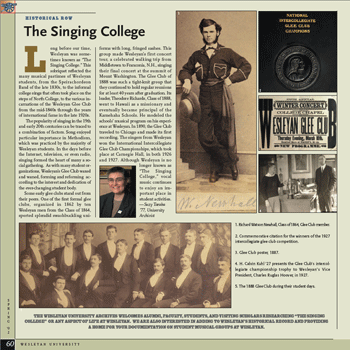HISTORICAL ROW: THE SINGING COLLEGE
 Long before our time, Wesleyan was sometimes known as “The Singing College.” This sobriquet reflected the many musical pastimes of Wesleyan students, from the Speirachordeon Band of the late 1830s, to the informal college sings that often took place on the steps of North College, to the various incarnations of the Wesleyan Glee Club from the mid-1840s through the years of international fame in the late 1920s.
Long before our time, Wesleyan was sometimes known as “The Singing College.” This sobriquet reflected the many musical pastimes of Wesleyan students, from the Speirachordeon Band of the late 1830s, to the informal college sings that often took place on the steps of North College, to the various incarnations of the Wesleyan Glee Club from the mid-1840s through the years of international fame in the late 1920s.
The popularity of singing in the 19th and early 20th centuries can be traced to a combination of factors. Song enjoyed particular importance in Methodism, which was practiced by the majority of Wesleyan students. In the days before the Internet, television, or even radio, singing formed the heart of many a social gathering. As with many student organizations, Wesleyan’s Glee Club waxed and waned, forming and reforming according to the interest and dedication of the ever-changing student body.
Some early glee clubs stand out from their peers. One of the first formal glee clubs, organized in 1862 by ten Wesleyan men from the Class of 1864, sported splendid swashbuckling uniforms with long, fringed sashes. This group made Wesleyan’s first concert tour, a celebrated walking trip from Middletown to Franconia, N.H., singing their final concert at the summit of Mount Washington. The Glee Club of 1888 was such a tight-knit group that they continued to hold regular reunions for at least 40 years after graduation. Its leader, Theodore Richards, Class of 1888, went to Hawaii as a missionary and eventually became principal of the Kamehaha Schools. He modeled the schools’ musical program on his experience at Wesleyan. In 1890, the Glee Club traveled to Chicago and made its first recording. The singers from Wesleyan won the International Intercollegiate Glee Club Championships, which took place at Carnegie Hall, in both 1926 and 1927. Although Wesleyan is no longer known as “The Singing College,” vocal music continues to enjoy an important place in student activities.
Suzy Taraba ’77, University Archivist
